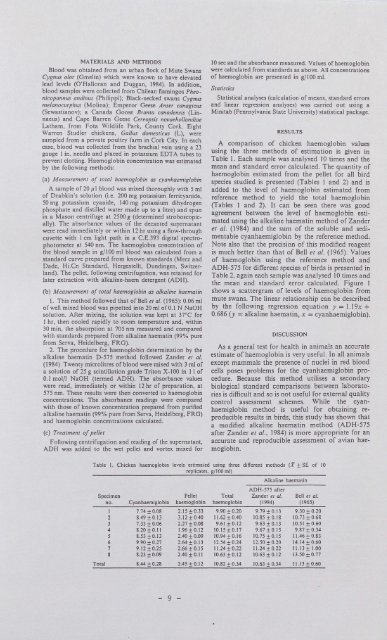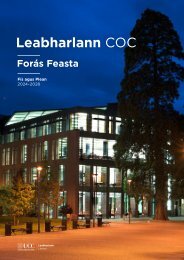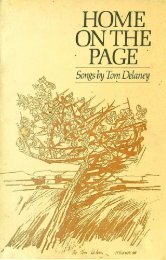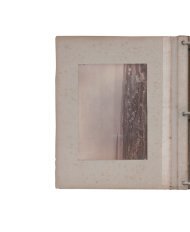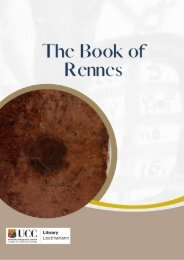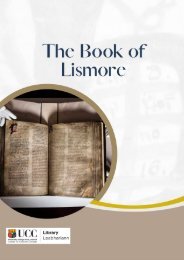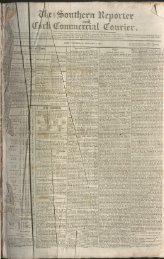Lead Toxicity in Mute Swans
LEAD TOXICITY IN MUTE SWANS Cygnus olor (Gmelin). By JOHN O'HALLORAN A thesis submitted to the National University of Ireland in candidature for the degree of Doctor of Philosophy September 1987
LEAD TOXICITY IN MUTE SWANS
Cygnus olor (Gmelin).
By
JOHN O'HALLORAN
A thesis submitted to the National University of Ireland
in candidature for the degree of Doctor of Philosophy
September 1987
You also want an ePaper? Increase the reach of your titles
YUMPU automatically turns print PDFs into web optimized ePapers that Google loves.
MATERIALS AND METHODS<br />
Blood was obta<strong>in</strong>ed from an urban ftock of <strong>Mute</strong> <strong>Swans</strong><br />
Cygnus olor (Gmel<strong>in</strong>) which were known to have elevated<br />
lead levels (O'Halloran and Duggan, 1984). In addition,<br />
blood samples were collected from Chilean flam<strong>in</strong>gos Pheonicopannus<br />
and<strong>in</strong>us (Philippi); Black-necked swans Cygnus<br />
melanocurphus (Mol<strong>in</strong>a); Emperor Geese Anser canagicus<br />
(Sewastianov); a Canada Goose Branta canadensis (L<strong>in</strong>naeus)<br />
and Cape Barren Geese Cereopsis novaehollandiae<br />
Latham, from Fota Wildlife Park, County Cork. Eight<br />
Warren Studler chickens, Gallus domesticus (L), were<br />
sampled from a private poultry fann <strong>in</strong> Cork City. In each<br />
case, blood was collected from the brachia! ve<strong>in</strong> us<strong>in</strong>g a 23<br />
gauge l <strong>in</strong>. needle and placed <strong>in</strong> potassium EDTA tubes to<br />
prevent clott<strong>in</strong>g. Haemoglob<strong>in</strong> concentration was estimated<br />
by the follow<strong>in</strong>g methods:<br />
(a) Measurement of total haemoglob<strong>in</strong> as cyanhaemiglob<strong>in</strong><br />
A sample of 20 µl blood was mixed thoroughly with 5 ml<br />
of Drabk<strong>in</strong>'s solution (i.e. 200 mg potassium ferricyanide,<br />
50 mg potassium cyanide, 140 mg potassium dihydrogen<br />
phosphate and distilled water made up to a litre) and spun<br />
<strong>in</strong> a Mason centrifuge at 2500 g (determ<strong>in</strong>ed stroboscopically).<br />
The absorbance values of the decanted supernatant<br />
were read immediately or with<strong>in</strong> 12 hr us<strong>in</strong>g a flow-through<br />
cuvette with 1 cm light path <strong>in</strong> a C.E.393 digital spectrophotometer<br />
at 540 nm. The haemoglob<strong>in</strong> concentration of<br />
the blood sample <strong>in</strong> g/100 ml blood was calculated from a<br />
standard curve prepared from known standards (Merz and<br />
Dade, Hi.Cn Standard, Hergestellt, Dund<strong>in</strong>gen, Switzerland).<br />
The pellet, follow<strong>in</strong>g centrifugation, was reta<strong>in</strong>ed for<br />
later extraction with alkal<strong>in</strong>e-haem detergent (ADH).<br />
(b) Measurement of total haemoglob<strong>in</strong> as alkal<strong>in</strong>e haemat<strong>in</strong><br />
l. This method followed that ofBell et al. (1965): 0.06 ml<br />
of well mixed blood was pipetted <strong>in</strong>to 20 ml of 0.1 N Na OH<br />
solution. After mix<strong>in</strong>g, the solution was kept at 37°C for<br />
1 hr, then cooled rapidly to room temperature and, with<strong>in</strong><br />
30 m<strong>in</strong>, the absorption at 705 nm measured and compared<br />
with standards prepared from alkal<strong>in</strong>e haemat<strong>in</strong> (99% pure<br />
from Serva, Heidelberg, FRG).<br />
2. The procedure for haemoglob<strong>in</strong> determ<strong>in</strong>ation by the<br />
alkal<strong>in</strong>e haemat<strong>in</strong> D-575 method followed Zander et al.<br />
(1984). Twenty microlitres of blood were mixed with 3 ml of<br />
a solution of 25 g sc<strong>in</strong>tillation grade Triton X-100 <strong>in</strong> 11 of<br />
0.1 mol/l NaOH (termed ADH). The absorbance values<br />
were read, immediately or with<strong>in</strong> 12 hr of preparation, at<br />
575 nm. These results were then converted to haemoglob<strong>in</strong><br />
concentrations. The absorbance read<strong>in</strong>gs were compared<br />
with those of known concentration prepared from purified<br />
alkal<strong>in</strong>e haemat<strong>in</strong> (99% pure from Serva, Heidelberg, FRG)<br />
and haemoglob<strong>in</strong> concentrations calculated.<br />
(c) Treatment of pellet<br />
Follow<strong>in</strong>g centrifugation and read<strong>in</strong>g of the supernatant,<br />
ADH was added to the wet pellet and vortex mixed for<br />
10 sec and the absorbance measured. Values of haemoglob<strong>in</strong><br />
were calculated from standards as above. All concentrations<br />
of haemoglob<strong>in</strong> are presented <strong>in</strong> g/100 ml.<br />
Statistics<br />
Statistical analyses (calculation of means, standard errors<br />
and l<strong>in</strong>ear regression analyses) was carried out us<strong>in</strong>g a<br />
M<strong>in</strong>itab (Pennsylvania State University) statistical package.<br />
RESULTS<br />
A comparison of chicken haemoglob<strong>in</strong> values<br />
us<strong>in</strong>g the three methods of estimation is given <strong>in</strong><br />
Table I. Each sample was analysed I 0 times and the<br />
mean and standard error calculated. The quantity of<br />
haemoglob<strong>in</strong> estimated from the pellet for all bird<br />
species studied is presented (Tables 1 and 2) and is<br />
added to the level of haemoglob<strong>in</strong> estimated from<br />
reference method to yield the total haemoglob<strong>in</strong><br />
(Tables I and 2). It can be seen there was good<br />
agreement between the level of haemoglob<strong>in</strong> estimated<br />
us<strong>in</strong>g the alkal<strong>in</strong>e haemat<strong>in</strong> method of Zander<br />
et al. (1984) and the sum of the soluble and sedimentable<br />
cyanhaemiglob<strong>in</strong> by the reference method.<br />
Note also that the precision of this modified reagent<br />
is much better than that of Bell et al. ( 1965). Values<br />
of haemoglob<strong>in</strong> us<strong>in</strong>g the reference method and<br />
ADH-575 for different species of birds is presented <strong>in</strong><br />
Table 2, aga<strong>in</strong> each sample was analysed 10 times and<br />
the mean and standard error calculated. Figure I<br />
shows a scattergram of levels of haemoglob<strong>in</strong> from<br />
mute swans. The l<strong>in</strong>ear relationship can be described<br />
by the follow<strong>in</strong>g regression equation y = l. l 9x +<br />
0.686 (y = alkal<strong>in</strong>e haemat<strong>in</strong>, x = cyanhaemiglob<strong>in</strong>).<br />
DISCUSSION<br />
As a general test for health <strong>in</strong> animals an accurate<br />
estimate of haemoglob<strong>in</strong> is very useful. In all animals<br />
except mammals the presence of nuclei <strong>in</strong> red blood<br />
cells poses problems for the cyanhaemiglob<strong>in</strong> procedure.<br />
Because this method utilises a secondary<br />
biological standard comparisons between laboratories<br />
is difficult and so is not useful for external quality<br />
control assessment schemes. While the cyanhaemiglob<strong>in</strong><br />
method is useful for obta<strong>in</strong><strong>in</strong>g reproducible<br />
results <strong>in</strong> birds, this study has shown that<br />
a modified alkal<strong>in</strong>e haemat<strong>in</strong> method (ADH-575<br />
after Zander et al., I 984) is more appropriate for an<br />
accurate and reproducible assessment of avian haemoglob<strong>in</strong>.<br />
Table 1. Chicken haemoglob<strong>in</strong> levels estimated us<strong>in</strong>g three different methods (.f ± SE of 10<br />
replicates, g/ I 00 ml)<br />
Alkal<strong>in</strong>e haemat<strong>in</strong><br />
ADH-575 after<br />
Specimen Pellet Total Zander et al. Bell et al.<br />
no. Cyanhaemiglob<strong>in</strong> haemoglob<strong>in</strong> haemoglob<strong>in</strong> (1984) (1965)<br />
1 7.74 ± 0.08 2.15±0.33 9.90 ± 0.20 9.79±0.13 9.30 ± 0.20<br />
2 8.49±0.13 3.12±0.40 11.62 ± 0.40 10.85 ± 0.18 10.73 ± 0.68<br />
3 7.33 ± 0.06 2.27 ± 0.08 9.61 ±0.12 9.63 ± 0.13 10.51 ± 0.60<br />
4 8.20 ± 0.11 1.96 ± 0.12 10.15±0.17 9.67±0.15 9.87 ± 0.34<br />
5 8.53 ± 0.13 2.40 ± 0.09 10.94 ±0.16 10.75±0.15 11.46 ± 0.83<br />
6 9.90 ± 0.27 2.64±0.13 12.54 ± 0.24 12.50 ± 0.20 14.14 ± 0.60<br />
7 9.12±0.25 2.66 ± 0.15 11.24 ± 0.22 11.24 ± 0.22 11.13 ± 1.00<br />
8 8.23 ± 0.09 2.40 ± 0.11 10.63 ± 0.12 10.63 ± 0.12 13.50 ± 0.77<br />
Total 8.44 ± 0.28 2.45±0.12 10.82 ± 0.34 10.63 ± 0.34 11.13 ±0.60<br />
- 9 -


